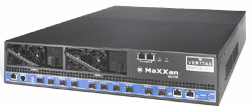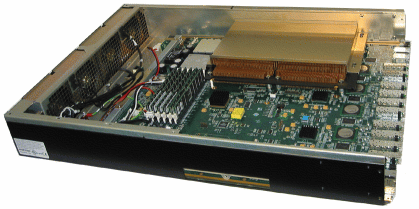Article: Device profile: MaXXan SG100 storage gateway
Feb 27, 2003 — by LinuxDevices Staff — from the LinuxDevices Archive — 3 viewsMaXXan characterizes its Linux-powered SG100 Storage Gateway system as a tightly integrated, easily deployed, storage gateway solution which meets the needs of companies' converging NAS (network attached storage) and SAN (storage area network) storage requirements.
Key strengths of the SG100, according to MaXXan, are its high-performance architecture, highly integrated design, and high availability configurations — all of which make it an ideal platform for independent NAS systems for distributed environments, as well as for creating scalable NAS systems in a SAN environment.

What's inside?
The SG100 is powered by dual 2.4 GHz Intel Xeon processors with from 4 to 12 GB of DDR DRAM, running an embedded Linux operating system. Internal disk storage is based on IBM micro-drives.
The system provides the following external interfaces . . .
- 10 auto-sensing 1 or 2 Gbps Fibre Channel ports (switched FC, FC-AL and JBOD)
- 2 auto-negotiating 10/100/1000Base-T Ethernet ports
Management Ports:
- 3 10/100Base-T Ethernet ports (1 for management, 2 for heartbeat between clustered systems)
- 1 serial port

The SG100's embedded Linux OS
The SG100's operating system is VXOS (Veritas modified RedHat 7.2), which runs a modified kernel version 2.4.9. MaXXan did all their coding in user space and loadable modules, eliminating the need to modify the Linux kernel, explained Jeff Silva, MaXXan co-founder and vice president of marketing. The device is implemented as a “black box,” without any display for system management interface purposes; all administrative access is via the serial port or through web browsers and an embedded Apache webserver.
In addition to Linux, other Linux-based and open source software components used in the device include . . .
- 802.3ad from Intel for trunking Ethernet interfaces
- Apache Web server and applicable CGI-BIN scripts for platfo4rm management
- SNMP agent and applicable platform management sub-agents
- “CLI” commands for facilitating platform management
- Remote software upgrade
Why Linux?
“Linux was our system of choice,” recalled Silva. “Everybody knows that it is easy to set up a network on a Linux machine, because Linux handles most of the work — the developer only has to provide the correct addresses.”
“Linux is perfect for storage networking,” Silva added. “Linux's scalability, high efficiency and the fact that it is royalty-free help us achieve our goal [of] making SAN management simple for our customers while providing excellent price/performance. Of course, the availability of its source code and its popularity among programmers are incontestable advantages.
“Our products are non-proprietary solutions and we understand how important this is for our customers,” continued Silva. “Linux eliminates the monopoly of a single vendor and lets you add new functions in the operating system while other companies are doing the same. This means that our intelligence combined with their intelligence will create a better solution.”
“More and more customers recognize the importance of Linux in their enterprises and they incorporate it in their new products. Linux provides the features needed by next-generation solutions like the SG100. Our experience shows that the scalability and security of Linux makes it the preferred operating systems for our customers. We expect the embedded Linux share of the embedded software market to increase substantially in the near future. The current state of the economy is the right time to start saving money and time with a faster and cost-effective operating system,” Silva said.
This article was originally published on LinuxDevices.com and has been donated to the open source community by QuinStreet Inc. Please visit LinuxToday.com for up-to-date news and articles about Linux and open source.